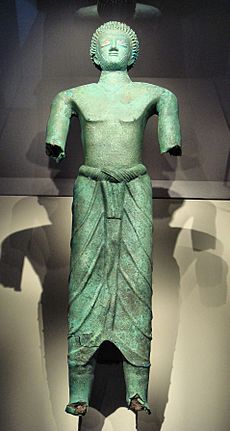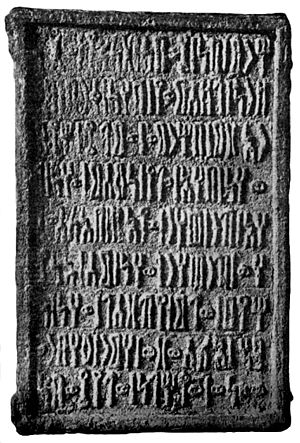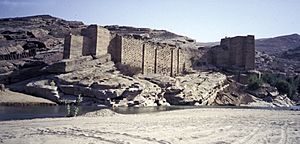Sabaeans facts for kids
Quick facts for kids
Sabaean Kingdom
|
|||||||||
|---|---|---|---|---|---|---|---|---|---|
| 1200 BC–275 AD | |||||||||

Map of the Kingdom in the 2nd century BC
|
|||||||||
| Capital | Ma'rib | ||||||||
| Common languages | Sabaic | ||||||||
| Religion | South Arabian polytheism | ||||||||
| Demonym(s) | Sabaean | ||||||||
| Government | Theocracy (Early) Monarchy (Late) |
||||||||
| Mukarrib | |||||||||
|
• 700–680 BC
|
Karibi-ilu | ||||||||
|
• 620–600 BC
|
Karib'il Watar | ||||||||
|
• 60–20 BC
|
Ilasaros | ||||||||
| Historical era | Iron Age to Antiquity | ||||||||
|
• Established
|
1200 BC | ||||||||
|
• Disestablished
|
275 AD | ||||||||
|
|||||||||
| Today part of | Yemen or South Arabia | ||||||||
The Sabaeans were an ancient group of people from South Arabia. They spoke a language called Sabaic. They created the kingdom of Sabaʾ in what is now Yemen. Many people believe this was the biblical land of Sheba. It was known as the oldest and most important kingdom in South Arabia.
Historians do not fully agree on when Sabaʾ began. Some say it started around 1200 BCE and lasted until 275 CE. Its capital city was Maʾrib. Other historians think the Sabaean kingdom really grew strong from the 8th century BCE onwards. The kingdom ended after a long civil war. The Himyarite Kingdom then took over.
The Sabaeans are mentioned in the Hebrew Bible many times. In the Quran, they are called Sabaʾ or the "People of Tubbaʿ."
Contents
History of the Sabaean Kingdom
The exact start of the Sabaean Kingdom is not fully known. Some experts believe it began around 1200 BCE. Others think it became powerful later, around the 8th century BCE. The Sabaeans were originally one of many "communities" living near the Sayhad desert.
Early on, their leaders, called Mukarribs, united many of these communities. They formed a large kingdom that covered much of South Arabia.
The Sabaean kingdom faced a big decline by the end of the 1st millennium BCE. The Himyarites conquered Saba' in the 1st century BCE. However, the Sabaean Kingdom reappeared in the early 2nd century CE. This "Middle Sabaean Kingdom" was different in many ways from the older one. The Himyarites finally conquered the Sabaean kingdom for good in the late 3rd century CE. The capital city was Ma'rib. It was located in a desert area called Sayhad.
The Sabaean people spoke their own ancient language, Sabaean. Other kingdoms in ancient Yemen included the Minaeans, Qatabānians, and Ḥaḑramites. The Sabaeans, like these other kingdoms, were very involved in the profitable spice trade. They traded valuable items like frankincense and myrrh. They left behind many writings carved into stone, called Musnad. They also wrote documents using a different script called Zabūr.
Religious Beliefs
The Sabaeans believed in both the visible world and a spiritual world. They did not follow strict religious laws. Instead, they focused their worship on spiritual beings and forces.
Sabaeans in Religious Books
In Baha'i Writings
The Sabaeans are mentioned in Baha'i writings. They are seen as an ancient people with their own religious practices. Their religion is considered one of God's true religions. It is part of a long history where God guides humanity by sending teachers over time. They are also mentioned as possibly helping to create the science of logic.
In the Bible
The Sabaeans appear in several books of the Hebrew Bible. These include Genesis, 1 Kings, Isaiah, Joel, Ezekiel, and Job.
One famous story is about Solomon and the Queen of Sheba in 1 Kings. In the Book of Job, the Sabaeans are said to have killed Job's animals and servants. In Isaiah, they are described as being "tall of stature."
In the Qur'an
The name Saba' is mentioned twice in the Qur'an. It appears in the 27th and 34th chapters. The 34th chapter is even named after the area.
The 27th chapter talks about Solomon and the Queen of Sheba. The 34th chapter tells about the "Flood of the Dam." This is when the famous Marib Dam was destroyed by floods. The phrase "People of Tubbaʿ" is also used in the Qur'an. Tubbaʿ was a title for the kings of Saba', similar to how kings of Himyar were called.
See also
 In Spanish: Sabeos para niños
In Spanish: Sabeos para niños
- Ancient South Arabian art
- Azd
- Hamdan tribe
- Minaean Kingdom





